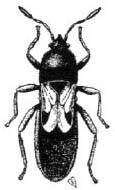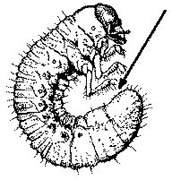
NOTE: We now have BIOTITAN to control insects such as Chinch Bug and Grubs. Please contact us for a quote!
 These insects are very small, about 2 mm in length, but what they lack in size, they make up for in numbers and destructive ability. Chinch Bugs over winter in the nymph stage under hedges and other protected areas. In the spring they move to feeding areas on the lawn. Most damage occurs in July and August, especially if the weather has been hot and dry.
These insects are very small, about 2 mm in length, but what they lack in size, they make up for in numbers and destructive ability. Chinch Bugs over winter in the nymph stage under hedges and other protected areas. In the spring they move to feeding areas on the lawn. Most damage occurs in July and August, especially if the weather has been hot and dry.
Damage appears as dry brown patches, that won't recover even after extensive watering. Chinch bug damage is often mistaken for a localized dry spot in the lawn. During their peak, the adults can be seen scurrying about near the thatch layer of the lawn in large numbers. They are black and white in colour, often with a tan line across their back, and resemble a tiny beetle. These insects suck the juice from the base of the leaf blade. The dead areas of lawn they create quickly fill with weeds.
Control using NEMETODES has some effect when applied in July.
 These insects comprise several species of large, white, hairless grubs which reach 4 cm in length. The adult, which does not damage turf, is a large brown or black beetle appearing in May or June, hence it's name June beetle.
These insects comprise several species of large, white, hairless grubs which reach 4 cm in length. The adult, which does not damage turf, is a large brown or black beetle appearing in May or June, hence it's name June beetle.
The grubs feed on the roots of plants, and are only visible when the sod is turned up using a shovel. A large concentration of grubs, more than 5 per square foot, can do considerable damage to a lawn. Damage from heavy feeding includes dead and wilted patches of grass, and grass which comes out in clumps, or feels spongy when walked on. Skunks and racoons may do more damage to a lawn in their attempt to get at the juicy larvae.
Control is easier while the grubs are young and not as deep in the soil, however, damage may not be present at this time.
 This insect's adult form is as the small grey or tan moths that flitter on the lawn in June. They lay hundreds of eggs at this time, which hatch and as caterpillars start to feed on grass. The caterpillars are 2cm long, tan in colour, with a dark brown head. The caterpillars remain in the soil and thatch layer where they feed on the upper roots and plant stems. The appearance of tunnels in the thatch layer, and grass which pulls out in large clumps are signs that sod webworm is present. Birds feeding on the caterpillars in the lawn is another sign.
This insect's adult form is as the small grey or tan moths that flitter on the lawn in June. They lay hundreds of eggs at this time, which hatch and as caterpillars start to feed on grass. The caterpillars are 2cm long, tan in colour, with a dark brown head. The caterpillars remain in the soil and thatch layer where they feed on the upper roots and plant stems. The appearance of tunnels in the thatch layer, and grass which pulls out in large clumps are signs that sod webworm is present. Birds feeding on the caterpillars in the lawn is another sign.
These pests can do extensive damage to a lawn in early fall when numbers are high. Over lapping generations in one year make control more difficult.
There are other insect pests that can do damage to lawns as well as the ones mentioned above. These may include Billbugs,Cutworms and Scale. It is important to identify the insect properly, and use effective control measures at a time when the insects are most likely to be destroyed.